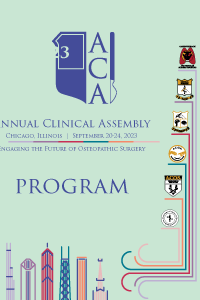General Surgery
Benefits to Community Health from a Student Run Non-profit Pediatric Wellness Clinic
- MM
Margaret L. Munz
VCOM-Carolinas
Califon, New Jersey, United States
Primary Presenter(s)
Community screening programs have been in effect since they were utilized in the 19th century at county fairs. A free pediatric health screening program was created by an osteopathic medical school in South Carolina in collaboration with a pediatric dental outreach organization to engage the local underserved community and train community-minded medical professionals. This study sought to demonstrate the efficacy and need for a student-run monthly pediatric health screening program in an underserved pediatric demographic.
Methods or Case Description:
A retrospective study of pre-existing de-identified data obtained from a student-run health screening program was analyzed to determine the efficacy of the screening program in detecting chronic health risk factors in children in an underserved population. Patients were recruited through a partnership with a free dental clinic. The free dental clinic screened for dental abnormalities at local schools in grades k-12 then referred patients without insurance who produced any positive dental abnormalities to their established clinic for further workup. Patients that attended the clinic were then offered the opportunity to have a free health assessment following their dental visit. The function of this program was unique in that uninsured, underserved patients were provided free dental care and a free health assessment. In partnership with a dental clinic for underserved and uninsured children, the health screening program offered comprehensive health screening to children after their dental appointments. Pediatric patients were screened for basic health information such as weight, height, BMI, vision, cardiovascular health, hypertension, asthma (reported via questionnaire by either the parent or child when applicable), nutrition, and lead poisoning (via questionnaire). The program also offered families additional support by connecting them to local resources and answering any questions they had about their children’s health. Data from fourteen health screening events was collected for quality improvement and efficacy monitoring. Descriptive analyses performed.
Outcomes:
The health screening program assessed 124 children between October 2021 and March 2023 over fourteen health screening events. The patients ranged from one year old to 26 years old with a mean of 9.65 years old. Patients were predominantly Hispanic (79.67%). About one third (27.64%) of children that were screened had positive findings associated with increased risk for chronic disease. Nearly half (43.90%) of families that were screened requested further information on ways to obtain health insurance and regular primary care services (utilized Access Health). Of the one third of children with positive risk factors, 12.20 % reported positive findings associated with asthma. Of the patients with positive risk factors 8.94% had vision abnormalities, most of whom had not been seen by an ophthalmologist. This preliminary analysis will be followed by a secondary analysis that further looks into patient demographic (primarily Hispanic) as well as age distribution across various risk factors.
Conclusion: This pediatric health screening program has demonstrated a basic level of efficacy by successfully identifying increased risk for chronic disease in the underserved pediatric population. The need for these screening events was highlighted by the identification of untreated positive findings

